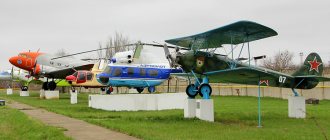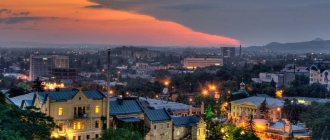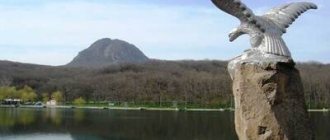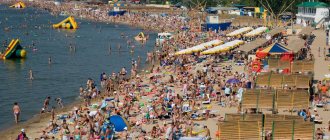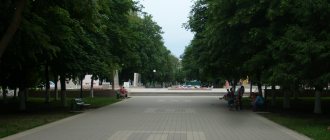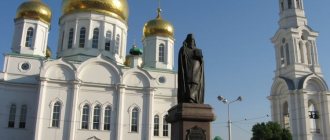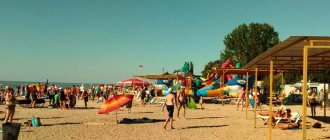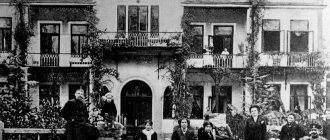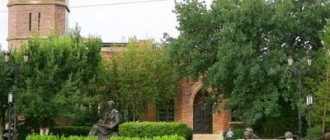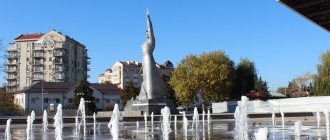Judging by the news, a mass opening of borders will not take place this summer. For the tourist regions of our country, this is an excellent chance to attract new guests: to surprise with natural beauty, local cuisine, history and architecture. One of these regions is encrypted with the abbreviation KMV, which for many still remains just a set of letters. Before the start of the holiday season, we will reveal this secret together with Vera Dyachkova, a guide from Kislovodsk and the author of the channel “Across the Mountains and Cities” in Zen.
What are Kavminvody and where are they located?
Caucasian Mineral Waters (aka Kavminvody, KMV) is one of the oldest resort regions in Russia. Research into thermal springs began in the 18th century by order of Peter I, and since 1803 the cities of Pyatigorsk and Kislovodsk have been resorts of state (later federal) significance. The region is located in the south of Russia in the Stavropol Territory, equidistant from the Azov and Black Seas. The location at the junction of the steppe and foothills causes differences in climate, although the distances between the cities are very small.
Caucasian Mineral Waters region on the map of Russia
The Caucasian Mineral Waters includes the resort cities of Pyatigorsk, Zheleznovodsk, Essentuki and Kislovodsk, as well as three districts of the neighboring republics of Karachay-Cherkessia and Kabardino-Balkaria. Contrary to its name, the city of Mineralnye Vody is not a resort, but serves as a transport hub. The airport closest to CMV is located here.
Main cities of Kavminvod
Since its founding, the main task of the CMS cities has been the treatment of a very wide range of diseases, as well as the general improvement of the body. However, now more and more guests of the region combine treatment, trips to the mountains, and excursions to historical city centers. Unfortunately, there is not much entertainment for children yet.
Pyatigorsk
The largest city in the region and the capital of the North Caucasus Federal District is Pyatigorsk with a population of about 150 thousand people. It is also the oldest city in the CMS, dating back to 1780. In Pyatigorsk, the historical center, described by M.Yu. Lermontov in “A Hero of Our Time,” is perfectly preserved. For example, you can visit the drinking gallery where Pechorin first saw Princess Mary, and also visit the house of Lermontov himself. Pyatigorsk has a wide range of mineral springs, from salt-alkaline to radon, which makes it possible to treat many different diseases. And lovers of active recreation can go on one-day hikes to the Beshtau and Mashuk mountains right in the city, or paraglid from Mount Yutsa.
Paragliding from Mount Yutsa. Photo: paradrive.ru
Pyatigorsk is considered the most party and noisy city on the CMS, because there are many universities and the highest business activity in the region. Thanks to this, the choice of cafes, restaurants and other recreational places is greater than in other cities. There are several shopping centers that are large by local standards, but they are unlikely to surprise residents of cities with a population of over a million. One of the recently renovated and popular places is the Upper Market with the World Cuisines pavilion, where there is a large food court. Here you can try different types of kebabs, pomegranate sauce narsharab, Dagestan flatbreads stuffed with chudu and much more.
Zheleznovodsk
Not far from the airport, on the slope of Mount Zheleznoy, the smallest city of the KMV is hidden - Zheleznovodsk. Its population is only 60 thousand people, and the resort area with sanatoriums is located away from residential areas. So silence and cozy regularity are guaranteed to you! A real broad-leaved forest park will surprise you not only with paths, but also with architectural wonders - for example, there is a very beautiful dacha of the Emir of Bukhara and the longest Cascade Staircase in the south of Russia, about 1 km long!!
Palace of the Emir of Bukhara
The city's springs are unique in composition and temperature; water from the well comes hot and cools for supply to the pump rooms. This has led to the city’s medical specialization - people come here for diseases of the genitourinary system, kidneys, and liver.
In Zheleznovodsk everything is very calm and measured. As in our other small cities, after 8 pm you can only find tourists on the streets. As a rule, these are those who return after dinner at the few restaurants in the city. One of the most popular is Pizza Land near the railway station.
Cascade staircase in Zheleznovodsk
Essentuki
The youngest city in the region is Essentuki. Initially, there was just a Cossack post here, guarding the road from Pyatigorsk to Kislovodsk. And only after the discovery of the springs was the Cossack village founded, and then the dacha town. Now the city has a population of about 120,000. Sanatoriums and hotels are mainly located around the Medical Park and the historical center, the whole of which can be walked on foot in 2-3 hours. Essentuki springs No. 4 and No. 17 are perhaps the most famous in the country.
Source No. 17 in Essentuki
However, for bottling, the water is saturated with a preservative gas, so the taste of real pump room water will pleasantly surprise you. The city's salt-alkaline water is indicated for the treatment of diseases of the gastrointestinal tract, primarily. There is also a Diabetes Treatment Center in the city.
In Essentuki, many people go to the market - new, clean. with a large selection of local products, as well as delicacies from neighboring republics and even countries. All restaurants and cafes in the city are concentrated around the Healing Park. On the adjacent streets you can find restaurants serving national cuisine and classic cafes.
Kislovodsk
Kislovodsk, the most remote city of Kavminvod, is located in the foothills, which determines the special climate of this place. It is only 65 km from the city to Elbrus in a straight line, so there is no sweltering heat here in summer. The altitude above sea level is on average 800 m, which is significantly higher than in other cities of the KMS. The air here is clean and thinner, which is why the city is very popular with athletes. A large sports complex was built here for the 1980 Olympics. Well, the location in a valley between mountain ranges ensures stable dry weather - in Kislovodsk there are about 200 sunny days a year!!
There are 42 sanatoriums for a population of 130 thousand; the city ranks second in the country after Sochi in terms of the number of medical institutions. The water here also has its own - Narzan, but the city is more famous for the combination of balneological factors that make it possible to successfully treat diseases of the musculoskeletal system and the cardiovascular system.
Almost all the restaurants and cafes in the city are concentrated on Kurortny Boulevard - from the Snezhinka cafe with its famous fried donuts to the Vysota 5642 restaurant, part of the Novikov Group. Kislovodsk, along with Pyatigorsk, is one of the most expensive cities of the KMS, and food prices are no exception. If you move a little away from the boulevard, you will find small local and very pleasant establishments. For example, Noir House, which serves Mexican-American dishes, is very popular among locals.
Read more: “Big guide to Kislovodsk: Narzan, running and walking in the national park.”
Essentuki mud baths
The most visited place of all excursions in Essentuki is the mud bath, which is considered the most beautiful in Europe. It is located in the city center on Semashko Street near the Resort Park.
The completely unusual mud bath complex resembles a temple building with sculptures of lions at the entrance. By the way, it was near these lions that the scene in the film “12 Chairs” was filmed, when Kisa Vorobyaninov begged for alms to the “former deputy of the State Duma.”
The mud baths were opened in 1915. The complex is designed in the image of ancient Roman baths, which in the ancient world were not only baths, but a public place. The complex includes many sculptures, including the god of medicine Aesculapius and his daughter Hygieia, the goddess of health and purity.
The mud bath consists of 4 buildings with 180 seats. Treatment procedures are still carried out today, with virtually no changes in composition.
Newlyweds often hold photo sessions here; if you want to photograph the complex “without witnesses,” it is better to come here early in the morning.
Safety
One of the most common myths about the Caucasus in general and the CMS in particular is that the locals here are unfriendly and aggressive. I hasten to dispel these rumors. I have been living here permanently for two years now and have never felt an unfriendly attitude. As elsewhere, you need to follow certain rules - do not discuss religion and nationalities (representatives of about 80 nationalities live on the CMS), do not enter into discussions about the deportation of 1942-1943, and do not show an arrogant attitude. What I'm afraid of is some drivers whose driving style is very peculiar. So be careful, be sure to buckle up and keep your distance! Otherwise everything is very calm.
Cathedral of the Intercession of the Blessed Virgin Mary
This architectural structure is the most visited place in the Stavropol Territory. Construction of the temple began in 1992. Over the course of 5 years, the church was erected by architects, builders and skilled craftsmen.
The cathedral is made of brick and figured masonry. The architectural complex is equipped with several steel domes. On the territory of the cathedral there are cells for pilgrims, service rooms, and an administrative building. There are flower beds planted in the yard, which are especially beautiful in early spring. The attraction is a monument of Orthodox culture.
Location: Pyatigorskaya street.
Where to live in Kavminvody?
If you come to our region for treatment, then the choice of city should be made after consultation with a doctor. If the main goal is to relax and take a walk, then it is most convenient to live in Pyatigorsk and Kislovodsk.
It makes sense to live in sanatoriums if you are not coming for treatment, since in most cases a number of procedures are already included in the cost of accommodation. However, you need to keep in mind that there are, by definition, more sanatoriums in the cities of the KMS than hotels and boarding houses. and there are no large chain hotels yet. Of course, you can rent an apartment to suit every taste and color. Both “grandmother’s” methods of renting housing at a railway station and international aggregators work. At the same time, there are not many apartments with modern, high-quality renovation, while “carpets with deer” prevail. Therefore, if you prefer to rent a good apartment, it is better to do this in advance. You should look for apartments on Airbnb, Booking and Sutochno.ru.
Typical apartment options in KMV:
Good options are worth booking in advance. For example, this option in the resort area of Kislovodsk has already been booked for almost the entire summer (price - 16,000 rubles per week for a studio). Just like this house on the territory of the weather station.
Theater Park building
On the territory of the Resort Park in 1901, a building in the style of late classicism “Theater-Park” was built.
The building was used for walks in inclement weather, and in the evenings it was a concert hall. This was the only music venue in the city where famous singers gave concerts, among them Chaliapin F.I. and Sobinov L.V., ballet and orchestral performances were held. But in 1980, a concert hall named after F. Chaliapin was opened in the city and the Park Theater stopped giving concerts.
Currently, the building hosts ceremonial events, a small hotel, and a cafe in the summer.
Transport logistics KMV
The main transport hub of the region is the city of Mineralnye Vody. Almost all Russian airlines fly to Mineralnye Vody Airport, and tickets for 1,000 rubles one way are the norm. In addition, you can already fly inexpensively from Mineralnye Vody Airport to Turkey, Armenia and Kyrgyzstan.
Flights from Moscow to Mineralnye Vody for the summer of 2022 cost about 5-6 thousand rubles in both directions on baggage-free fares.
Such prices make Russian Railways completely uncompetitive: if you’re lucky, you can get a coupe from 2,800 rubles. But the train takes more than 30 hours.
The easiest way to get from the airport to the cities of the KMV is by taxi: for operators, a transfer to Kislovodsk, for example, costs about 1,000 rubles, for private owners up to 1,500, and Yandex.Taxi may be the cheapest. You can also rent a car in advance and pick it up upon arrival. There is no car sharing in the region yet.
The cities of the KMS are connected by roads and railways, so you can explore all the cities independently and quite comfortably. The Lastochka runs from Kislovodsk to MinVody several times a day; regular trains depart almost every half hour. For example, a train ticket from Kislovodsk to Pyatigorsk costs 110 rubles one way, travel time is 45 minutes. “Swallow” is a little faster and more expensive. The only city where trains go only on weekends and only twice a day is Zheleznovodsk. You can get here by taxi or minibus from Pyatigorsk. By the way, local residents practically do not use buses, because... bus stations are located on the outskirts and present a rather sad sight. Therefore, trains are the most convenient, comfortable and inexpensive way to travel.
Kislovodsk station
From Pyatigorsk it’s a little closer to go to Elbrus or Dombay, from Kislovodsk - to Bermamyt or Djily-Su. There are three ways to get to these places: with your own car, with a private guide, or with a large group excursion. The road to Elbrus is in excellent condition, and I recommend going to Dombay through Cherkessk - usually the navigator builds a route through the Gumbashi pass and Karachaevsk, but the road there is quite rough. You can easily explore these two most famous natural attractions on your own, although a local private guide can show you unobvious corners and gorges along the way.
It’s the same story with Djily-Su - the road is good, although there are a lot of serpentines. If you have thoroughly studied the reviews about observation decks and waterfalls, you will be able to handle the trip on your own.
Road to Djily-Su
But it is recommended to go to Bermamyt only for very confident drivers and in an SUV. There is no road here, only direction. A car with a private guide for a day costs 5-10 thousand, depending on the class of car and capacity. Well, excursions can be bought on every corner. For example, an excursion to Elbrus costs 1,500 plus 2,400 rubles for going up to all levels of the cable car.
Reminder for tourists
City Min. The population of our country loves water very much. But for a successful trip, listen to these tips:
- visit as many attractions as possible;
- you can come not only in summer, but also in winter;
- to observe the beauty of places and look at many cities of the North Caucasus, you need to climb the mountains - it’s unforgettable and beautiful;
- You can get there by car, train or plane, but don’t forget that an eagle is waiting for you at the station square;
- all cellular operators operate at the same tariffs;
- hotels and sanatoriums are equipped with everything necessary, there is Internet everywhere;
- as souvenirs you can bring water, a variety of dishes with symbols and landscapes of the city, attractions, magnets and even healing perfumes;
- If you climb mountains, it is recommended to take anti-nausea pills with you.
Religious sites
Second Athos Monastery
The monastery was founded in 1904 by monks, Father Sergius and Father John, who were natives of Athos, which explains the name of the temple. They wanted to find the most suitable place for a religious monastery. The paths of the monks diverged: one was looking for a place, and the other was looking for means for construction. Thanks to their work, a monastery arose.
Now on the territory of the Holy Dormition Second Athos Monastery there is a bakery, a bee apiary, a fraternal building, a chapel and open-air icons.
Church of All Saints
The Church of All Saints was built around 1988 and is a provincial church where they will listen to you, light a candle and pray for your loved ones.
Church of St. Nicholas the Wonderworker
The Church of St. Nicholas the Wonderworker was built in 1864 in the center of the village. Construction was carried out at the expense of local residents. Most of the icons in the temple are a gift from the villagers. Inside, under the dome, you can see a luxurious chandelier.
If you have not yet chosen where you will live and want to save money when booking, we recommend using the RoomGuru service. Firstly, it contains hotels, apartments and guest houses from many different booking systems, so you won’t miss out on a worthwhile option. Secondly, you can immediately compare prices for one place in different services and book where it is cheaper (this is not always Booking!).
Cathedral of the Intercession of the Blessed Virgin Mary
One of the most revered holy places in the city of Mineralnye Vody is the Cathedral of the Intercession of the Blessed Virgin Mary. The relics of the patron saint of the Stavropol region, Saint Theodosius of the Caucasus, are kept here. During his lifetime he was known as Elder Theodosius. The years of his life are 1868-1948. The elder was considered a miracle worker. It is believed that his remains are endowed with an inexplicable power that can work miracles. Thousands of believers make a pilgrimage to the cathedral every year.
By the way, the Cathedral of the Intercession of the Blessed Virgin Mary is also interesting for those who are interested in various holidays of architecture and history. After all, the cathedral consists of many buildings. These are the church, the service premises and the temple wall. The design of the buildings belongs to the architect Makkheyev. They are made in an eclectic style made of red brick. In addition, the architecture contains features of the architecture of Ancient Rus'
Therefore, the cathedral is very beautiful and attracts the attention of many
There is also something to see inside. It is worth noting the chapel dedicated to the Tikhvin Icon of the Mother of God. According to legend, it is known that she was found under a tree where the cathedral is located. They considered this a sign from above and built a temple on this site. It was built from 1992 to 1997. This is a fairly short period for the construction of such a facility. In the nineties, the mayor of the city chose the site where construction began. In 1990 this place was consecrated.
As a result, it turned out that on the lower floor there is the Tikhvin Icon of the Mother of God, the northern aisle was built in honor of Sergius of Radonezh, and the southern aisle was built in honor of John the Warrior Martyr. The carving of the iconostasis, made of wood, was carried out by the best craftsmen of that time. The interior painting is done in a beautiful elegant style. The design belongs to a group of Moscow artists.
On Sunday services, the ringing of the cathedral's eight bells can be heard throughout the city.
The blessing for the construction was given by Metropolitan Gideon. On October 14, 1997, the church was inaugurated. In August 1998, the relics of Theodosius of the Caucasus were transferred to the cathedral. A religious procession was held from the Mikhailo-Arkhangelsk region to the new Intercession Cathedral. Now parishioners come to church for services and prayers. It is recommended to attend church during service hours.
https://mineralnye-vody-1.cerkov.ru/
Pavilion of sources No. 4
In the Resort Park, to the right of the Nikolaev Baths, there is the Main Pavilion of Source No. 4. The water of this source is the most pleasant to the taste, it is compared with the best mineral waters in Europe. Available cold or warm. The water can be used as a medicinal table water.
The gallery building is modern, built in 1967. The facade is decorated with mosaics depicting women of different nationalities. Good technical equipment of the gallery allows water to flow from a well more than 150 meters deep.
This is the most visited pavilion. Nearby there are kiosks selling souvenirs and tickets for excursions.
